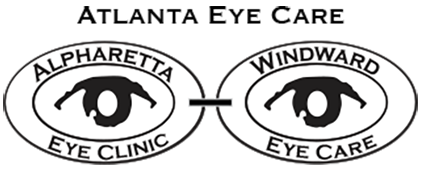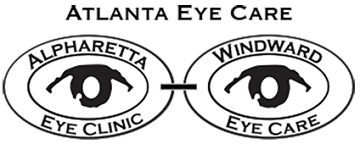The cornea is the clear, living tissue on the very front part of the eye. It is the transparent, dome-shaped surface that covers the front of the eye. The main function of the cornea is to allow light to pass into the eye so that it can reach the lens and the retina. A second chief function of the cornea is to help focus light, much like a camera lens. However, there are times when corneal disease presents itself.
Occasionally, either through disease or injury, surgery is needed to restore full vision or arrest declining eyesight. The optometrists at Alpharetta Eye Clinic and Windward Eye Care are skilled and experienced at treating all types of corneal disease.
Types of Corneal Disease
Corneal Ulcer
A corneal ulcer, or eyesore is an inflammatory or infective condition of the cornea. Corneal ulcers are extremely painful due to nerve exposure, and can cause tearing, squinting, redness of the eye and vision loss. It is a common condition in the tropics and developing countries. Children with Vitamin A deficiency are at high risk for corneal ulcer and may become blind in both eyes. Herpes can also cause these painful ulcers.
Proper and prompt diagnosis is essential. Bacterial corneal ulcers require intensive antibiotic therapy. Fungal corneal ulcers require intensive treatment with anti-fungal agents. Viral corneal ulcers caused by herpes virus are treated with antivirals. Superficial ulcers may heal in less than a week. Deep ulcers may require conjunctival grafts or conjunctival flaps, soft contact lenses, or corneal transplant. Proper protein intake, Vitamin C and Vitamin A are usually advised.
Keratoconus
Keratoconus is a disease of the cornea where there is a progressive thinning and bulging of the cornea so that it eventually takes on a cone shape. This generally is not a visible change to the naked eye, but the distortion in the shape of the cornea leads to worsening astigmatism and blurring of vision. Both eyes are usually affected, although one may be much worse than the other. There is no known cause of the disorder, and there is no clear hereditary pattern in most cases. The condition usually stabilizes in early adulthood, although there may be further worsening possible.
In cases where the vision cannot be improved with correction, or if contact lens use is not possible, a corneal transplant is an option. Corneal transplants are generally highly successful after keratoconus, although contact lenses may sometimes still be needed to fully correct the vision. Keratoconus does not recur in a transplant.
Pterygium
Pterygium most often refers to a benign growth of the conjunctiva, a delicate mucous membrane that covers the internal part of the eyelid and is attached to the cornea. A Pterygium is thought to be caused by exposure to sunlight, low humidity, and dust. As it is a benign growth, Pterygium usually does not require surgery unless it grows to such an extent that it covers the pupil, obstructing vision or presents with acute symptoms.
Some of the irritating symptoms can be addressed with artificial tears and definitive treatment is achieved only by surgical removal. Long-term follow up is required as Pterygium may recur.
Pinguecula
A Pinguecula is a yellowish, slightly raised abrasion that forms on the surface of the white part of your eye close to the edge of the cornea, a common type of degeneration of the conjunctiva, the delicate mucous membrane that covers the internal part of the eyelid and is attached to the cornea. In most people, Pingueculae cause few symptoms, however a Pinguecula might create a feeling that something is in the eye. In some cases, Pingueculae become swollen and inflamed, a condition called Pingueculitis. Irritation and eye redness from Pingueculitis usually result from exposure to sun, wind, dust or extremely dry conditions. Lubricating eye drops are usually prescribed for mild cases and surgical removal may be considered in severe cases when it interferes with vision, contact lens wear or blinking.
Fuchs’ Dystrophy
Fuchs’ Dystrophy is a slowly progressing corneal disease that usually affects both eyes, occurring more often in women than in men. Although doctors can often see early signs of Fuchs’ Dystrophy in people in their 30s and 40s, the disease rarely affects vision until people reach their 50s and 60s.
The early sign of this condition will be blurred vision on awakening that will gradually clear during the day. As the cornea retains fluids while we sleep it is normally thicker in the morning causing blurred vision. These fluids evaporate once we are awake. As the disease worsens, this swelling will remain constant and blurred vision will continue without clearing. If you suspect you have symptoms of Fuch’s dystrophy, schedule an eye examination immediately.
Treatment can include:
- Eye drops or ointments to reduce the amount of fluid in your cornea
- Use of a warm hair dryer at arm’s length two or three times a day to evaporate excess fluid in the cornea
- Wearing soft contact lenses to improve vision and reduce discomfort
- Receiving a corneal transplant
Corneal Edema
When the cornea is unable to keep itself clear, and fluid begins to accumulate, edema, or swelling, of the cornea occurs. The inside lining of the cornea (corneal endothelium) is responsible for keeping the cornea clear of fluid, and if this layer is becomes damaged symptoms of corneal edema may occur.
When mild, corneal edema may cause fluctuating or occasionally blurred vision. This may be worst when first opening the eyes after sleeping. One may see rainbows around headlights or streetlights. When severe, corneal edema can substantially blur the vision. Occasionally blisters may form on the surface of the eye (bullae), which can rupture and cause pain, like a corneal abrasion.
Treatment of corneal edema sometimes depends on its cause. Mild edema can be treated with hypertonic eye drops and ointment. This draws fluid out of the cornea and into the tears and helps to clear the cornea. More severe edema, especially with blister formation, may require a corneal transplant to correct.
Corneal Disease Surgical Options
Cornea Transplant
Corneal Transplantation, also known as corneal grafting or penetrating keratoplasty, surgically replaces a diseased cornea with donated corneal tissue. Eye surgeons perform the procedure on an outpatient basis.
DSAEK
DSAEK, a less invasive method of corneal grafting or transplant, leaves the eye much stronger and less prone to injury than full-thickness transplants, with a more rapid rate of visual recovery. Vision is typically restored in one to six months rather than one to two years.
Corneal Disease is nothing to ignore. If you live in North Fulton County, you can call the experts at Alpharetta Eye Clinic and Windward Eye Care located in Alpharetta, GA. This is a full-service optometry practice which caters to family eye needs and concerns. If you have a concern about your cornea or you just need an eye exam, call today. Both of our offices are convenient to those living in Roswell, Johns Creek, Milton, or Cumming.

